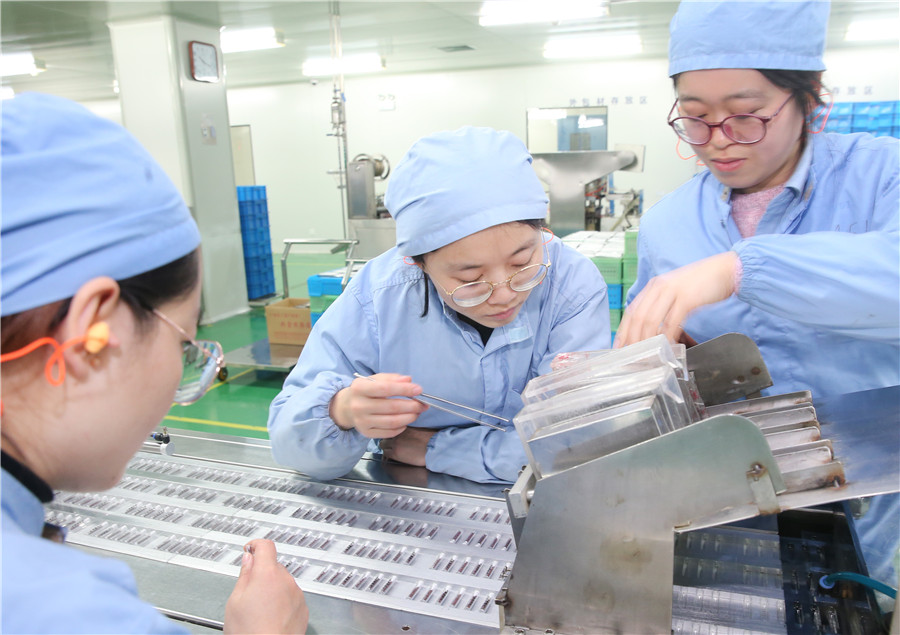


Employees check traditional Chinese medicine products at a factory in Nantong, Jiangsu province. [Photo by Xu Congjun/For China Daily]
Healthcare continued to be a sweet spot for investment in China, with funds to the tune of 82.6 billion yuan ($12.28 billion) flowing into the sector, up 78.64 percent on an annualized basis, in 2018.
Though much of the investments was fueled by the surging healthcare demands of the country's aging population, it was also aided by people's growing healthcare demand and policy support, said a recent industry report.
The report, published by medical research consultancy vcbeat.net, showed that fundraising in the country's medical sector has grown rapidly from the 6.72 percent seen in 2017 to the current level.
The pharmaceutical sector continued to be the mainstay of the investments and garnered 21.3 billion yuan of funds. The growth and number of deals in the sector were also significant at 210 percent and 245 percent respectively on a yearly basis. The biotechnology sector attracted investment of 11.1 billion yuan and was ranked second.
"The growth in pharmaceutical sector investments was probably due to the government's policy adjustments. The drug assessment reform and the pilot drug procurement program created new growth engines for the industry and raised investor confidence in the sector. However, as the industry settles down, it may not be able to replicate the momentum seen in 2018. This year, there may be a slight decline in pharmaceutical sector investments," the report said.
Chen Qiaoshan, a medical analyst at Beijing-based market research consultancy Analysys, said sustained demand helped fuel investments last year. "Demand for medicines has been growing steadily and increased investments would benefit patients in the form of more, better drugs to combat serious diseases."
Aside of the direct investments, the sector also saw a flurry of merger and acquisition deals. A total of 695 deals were completed last year, up 52.75 percent from the previous year. That number was close to the earlier record of 703 deals achieved in 2014. The medical device sector saw 141 transactions and was the leader in the number of deals.
Investment in the medical device sector surged as the government stepped up efforts to encourage scientific innovation. Minimally invasive companies, intelligent diagnosis companies, as well as medical imaging companies were the major beneficiaries," said Chen.
"From an investor's perspective, scientific breakthroughs led to new technologies, which in turn opened doors to the huge market in China," she said.
Most of the investment in 2018 was mainly in four sectors - medical devices, biotechnology, pharmaceuticals and medical digitization, accounting for 61.15 percent of the total deals, Chen said.
Shang Yang, a medical analyst at Beijing-based think tank EO Intelligence, said that "the investment surge has boosted investor confidence. The healthcare sector, as a non-periodic sector, will see investments grow on a yearly basis, with specific sectors expected to garner more financing support."
On a regional basis, most of the investments were mainly in Beijing and eastern coastal regions, with Shanghai, Beijing and Guangdong the top three in terms of the amount and number of deals. The number of deals in the three regions stood at 448, or 64.46 percent of the total.
At the same time, Sichuan province became the center of medical services in western China, with 28 investments and 27 deals in Chengdu.
According to Chen, investment growth in the healthcare sector will continue to pick up, considering that demand is growing and the industry is becoming more policy-oriented. Pharmaceuticals, wearables, rehabilitation equipment and medical finance will be the popular sectors for investment this year.
 Fire brigade in Shanghai holds group wedding
Fire brigade in Shanghai holds group wedding Tourists enjoy ice sculptures in Datan Town, north China
Tourists enjoy ice sculptures in Datan Town, north China Sunset scenery of Dayan Pagoda in Xi'an
Sunset scenery of Dayan Pagoda in Xi'an Tourists have fun at scenic spot in Nanlong Town, NW China
Tourists have fun at scenic spot in Nanlong Town, NW China Harbin attracts tourists by making best use of ice in winter
Harbin attracts tourists by making best use of ice in winter In pics: FIS Alpine Ski Women's World Cup Slalom
In pics: FIS Alpine Ski Women's World Cup Slalom Black-necked cranes rest at reservoir in Lhunzhub County, Lhasa
Black-necked cranes rest at reservoir in Lhunzhub County, Lhasa China's FAST telescope will be available to foreign scientists in April
China's FAST telescope will be available to foreign scientists in April "She power" plays indispensable role in poverty alleviation
"She power" plays indispensable role in poverty alleviation Top 10 world news events of People's Daily in 2020
Top 10 world news events of People's Daily in 2020 Top 10 China news events of People's Daily in 2020
Top 10 China news events of People's Daily in 2020 Top 10 media buzzwords of 2020
Top 10 media buzzwords of 2020 Year-ender:10 major tourism stories of 2020
Year-ender:10 major tourism stories of 2020 No interference in Venezuelan issues
No interference in Venezuelan issues
 Biz prepares for trade spat
Biz prepares for trade spat
 Broadcasting Continent
Broadcasting Continent Australia wins Chinese CEOs as US loses
Australia wins Chinese CEOs as US loses